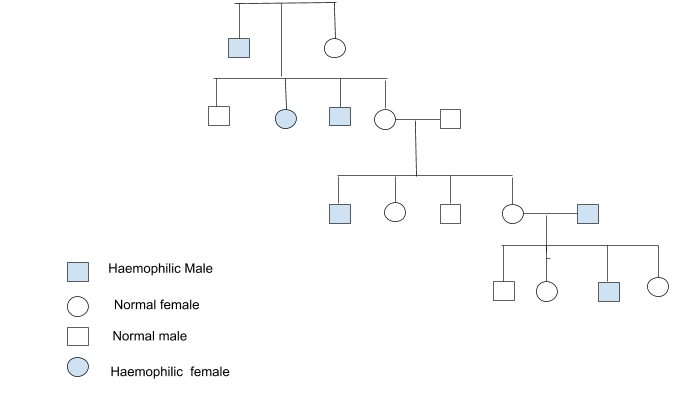Answer
425.4k+ views
Hint:Haemophilia is a largely hereditary genetic condition that impairs the capacity of the body to make blood clots, a mechanism that is important to avoid bleeding. This results in people bleeding after an injury for a longer period, quick swelling, and an increased risk of bleeding within joints or the brain.
Complete answer:
Characteristic signs differ according to severity. In general, internal or external bleeding episodes, called 'bleeds,' are symptoms. People with more severe haemophilia experience more severe and more frequent bleeding, while people with moderate haemophilia, even after surgery or severe injuries, typically experience more minor symptoms. In cases with severe haemophilia, symptoms that occur along a continuum between extreme and mild types are variable.
A condition carried by an X-linked gene is this disorder. There are two alleles for this gene. One where you do not have dominant haemophilia (H), and one where you do have recessive haemophilia (h). In women, as they have two X chromosomes, the disease is much less common. This is because if they are given one gene with haemophilia, they have a chance of having a non-hemophiliac gene from their other chromosome.
The haemophilia gene will cancel this, because they may not have the disorder. Of course, if there were two haemophilia genes given to a woman, they would have the disease. The mother (left side) in the test cross above is absolutely free of haemophilia.Father(top) is affected by haemophilia.
This is because the gene for haemophilia is not borne by the Y chromosome). In the two cases where the child may be a female, she carries the hemophilia gene, however it is counteracted by the non-hemophiliac gene, so while she would be a carrier, she would not have haemophilia.
Thus the correct answer is option (C) Haemophilia is X-linked recessive.
Note:Hemophilia is a recessive sex-linked condition. In males, these kinds of defects occur more frequently than in females.Hemophilia is more common among male children because they only inherit one X chromosome.
Complete answer:
Characteristic signs differ according to severity. In general, internal or external bleeding episodes, called 'bleeds,' are symptoms. People with more severe haemophilia experience more severe and more frequent bleeding, while people with moderate haemophilia, even after surgery or severe injuries, typically experience more minor symptoms. In cases with severe haemophilia, symptoms that occur along a continuum between extreme and mild types are variable.
A condition carried by an X-linked gene is this disorder. There are two alleles for this gene. One where you do not have dominant haemophilia (H), and one where you do have recessive haemophilia (h). In women, as they have two X chromosomes, the disease is much less common. This is because if they are given one gene with haemophilia, they have a chance of having a non-hemophiliac gene from their other chromosome.
| Xh | Y | |
| XH | XHXh | XHY |
| XH | XHXH | XHY |
The haemophilia gene will cancel this, because they may not have the disorder. Of course, if there were two haemophilia genes given to a woman, they would have the disease. The mother (left side) in the test cross above is absolutely free of haemophilia.Father(top) is affected by haemophilia.
This is because the gene for haemophilia is not borne by the Y chromosome). In the two cases where the child may be a female, she carries the hemophilia gene, however it is counteracted by the non-hemophiliac gene, so while she would be a carrier, she would not have haemophilia.
Thus the correct answer is option (C) Haemophilia is X-linked recessive.
Note:Hemophilia is a recessive sex-linked condition. In males, these kinds of defects occur more frequently than in females.Hemophilia is more common among male children because they only inherit one X chromosome.
Recently Updated Pages
Mark and label the given geoinformation on the outline class 11 social science CBSE

When people say No pun intended what does that mea class 8 english CBSE

Name the states which share their boundary with Indias class 9 social science CBSE

Give an account of the Northern Plains of India class 9 social science CBSE

Change the following sentences into negative and interrogative class 10 english CBSE

Advantages and disadvantages of science

Trending doubts
Difference between Prokaryotic cell and Eukaryotic class 11 biology CBSE

Which are the Top 10 Largest Countries of the World?

Fill the blanks with the suitable prepositions 1 The class 9 english CBSE

Differentiate between homogeneous and heterogeneous class 12 chemistry CBSE

Difference Between Plant Cell and Animal Cell

10 examples of evaporation in daily life with explanations

Give 10 examples for herbs , shrubs , climbers , creepers

Write a letter to the principal requesting him to grant class 10 english CBSE

How do you graph the function fx 4x class 9 maths CBSE




